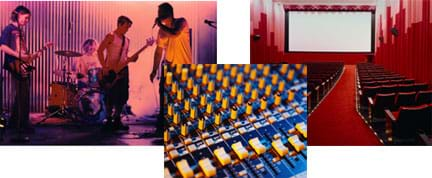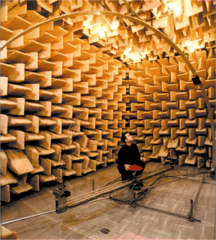
Summary
Students learn the connections between the science of sound waves and engineering design for sound environments. Through three lessons, students come to better understand sound waves, including how they change with distance, travel through different mediums, and are enhanced or mitigated in designed sound environments. They are introduced to audio engineers who use their expert scientific knowledge to manipulate sound for music and film production. They see how the invention of the telephone pioneered communications engineering, leading to today's long-range communication industry and its worldwide impact. Students analyze materials for sound properties suitable for acoustic design, learning about the varied environments created by acoustical engineers. Hands-on activities include modeling the placement of microphones to create a specific musical image, modeling and analyzing a string telephone, and applying what they've learned about sound waves and materials to model a controlled sound room.Engineering Connection
Many types of engineers must understand the behavior of sound waves to do their work. Audio engineers manipulate sound for the production of music, TV and film. Some engineers design recording studios, microphones and mixing equipment. Acoustical engineers design indoor and outdoor environments that enhance sound or mitigate noise. Communications engineers apply an understanding of sound waves to innovate cutting-edge technology of the global communications industry—everything from cell phones to the Internet.
Unit Overview
Lesson 1: Audio Engineers: Sound Weavers: how sound waves change with distance and an introduction to audio engineering and its vital role in music and movie production
Lesson 2: Sound Extenders: how sound travels, and how the telephone invention was the beginning of today's communications engineering
Lesson 3: Sound Environment Shapers: how sound and materials interact, through the exploration of environments designed by acoustical engineers
Subscribe
Get the inside scoop on all things TeachEngineering such as new site features, curriculum updates, video releases, and more by signing up for our newsletter!Unit Schedule
- Day 1: Audio Engineers: Sound Weavers lesson
- Day 2: Musical Images activity
- Day 3: Sound Extenders lesson
- Day 4: String Telephones activity
- Day 5: Sound Environment Shapers lesson
- Day 6: Form vs. Function activity
More Curriculum Like This

Students are introduced to the sound environment as an important aspect of a room or building. Several examples of acoustical engineering design for varied environments are presented.

Students are introduced to audio engineers, discovering the type of environment in which they work and exactly what they do on a day-to-day basis. Students come to realize that audio engineers help produce their favorite music and movies.

Students learn that sound is energy and has the ability to do work. Students discover that sound is produced by a vibration and they observe soundwaves and how they travel through mediums. They understand that sound can be absorbed, reflected or transmitted.

Students are introduced to the concept of the image of music. After listening to a song, they draw images of it by deciding where different musical instruments were placed during recording. They further investigate audio engineering by modeling the position of microphones over a drum set to create a...
Copyright
© 2008 by Regents of the University of ColoradoContributors
See individual lessons and activities.Supporting Program
Integrated Teaching and Learning Program, College of Engineering and Applied Science, University of Colorado BoulderAcknowledgements
This digital library content was developed by the Integrated Teaching and Learning Program under National Science Foundation GK-12 grant no. 0338326. However, these contents do not necessarily represent the policies of the National Science Foundation, and you should not assume endorsement by the federal government.
Last modified: August 22, 2017







User Comments & Tips